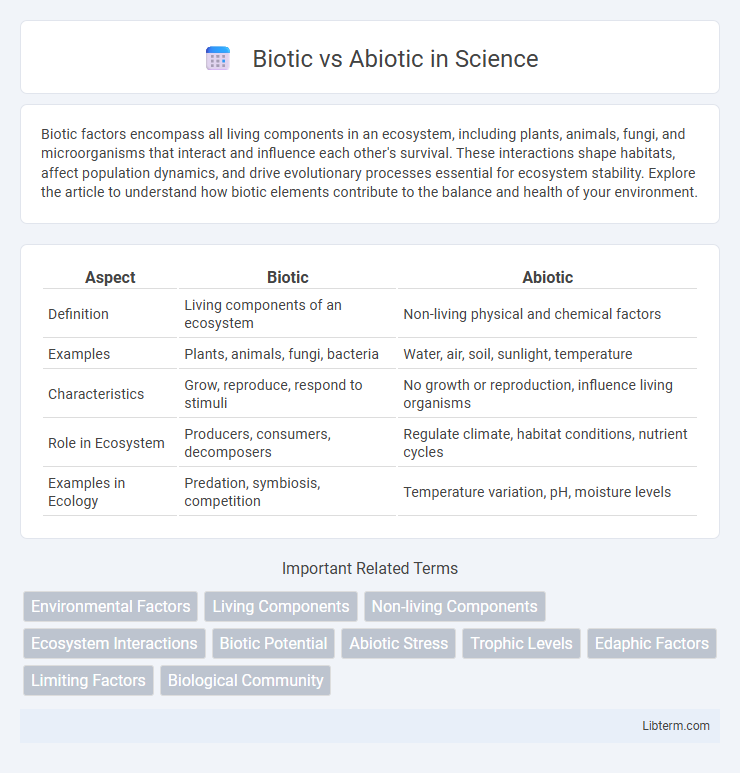Biotic factors encompass all living components in an ecosystem, including plants, animals, fungi, and microorganisms that interact and influence each other's survival. These interactions shape habitats, affect population dynamics, and drive evolutionary processes essential for ecosystem stability. Explore the article to understand how biotic elements contribute to the balance and health of your environment.
Table of Comparison
| Aspect | Biotic | Abiotic |
|---|---|---|
| Definition | Living components of an ecosystem | Non-living physical and chemical factors |
| Examples | Plants, animals, fungi, bacteria | Water, air, soil, sunlight, temperature |
| Characteristics | Grow, reproduce, respond to stimuli | No growth or reproduction, influence living organisms |
| Role in Ecosystem | Producers, consumers, decomposers | Regulate climate, habitat conditions, nutrient cycles |
| Examples in Ecology | Predation, symbiosis, competition | Temperature variation, pH, moisture levels |
Understanding Biotic and Abiotic Factors
Biotic factors encompass all living organisms in an ecosystem, including plants, animals, bacteria, fungi, and their interactions that influence survival and reproduction. Abiotic factors consist of non-living physical and chemical elements like temperature, water, sunlight, soil composition, and atmospheric gases, which shape habitat conditions. Understanding the dynamic interplay between biotic and abiotic factors is essential for analyzing ecosystem structure, energy flow, and environmental adaptability.
Defining Biotic Components
Biotic components refer to all living organisms within an ecosystem, including plants, animals, fungi, bacteria, and microorganisms, which interact with each other and their environment. These components influence ecosystem dynamics through processes like reproduction, predation, and symbiosis, driving energy flow and nutrient cycling. Understanding biotic factors is essential for studying biodiversity, ecological relationships, and ecosystem health.
Key Abiotic Elements in Ecosystems
Key abiotic elements in ecosystems include sunlight, temperature, water, soil composition, and atmospheric gases, all of which play critical roles in shaping habitats and influencing the survival of biotic components. Sunlight drives photosynthesis, while temperature regulates metabolic rates and seasonal behaviors of organisms. Water availability affects hydration and nutrient transport, soil composition determines nutrient supply, and atmospheric gases like oxygen and carbon dioxide facilitate respiration and photosynthesis essential for ecosystem function.
Differences Between Biotic and Abiotic Factors
Biotic factors consist of living organisms such as plants, animals, fungi, and microorganisms that interact within an ecosystem, influencing processes like reproduction and food chains. Abiotic factors are non-living physical and chemical components including temperature, sunlight, water, soil, and nutrients that shape the environment and affect living organisms' survival. The primary difference is that biotic factors are living entities driving ecological interactions, while abiotic factors are non-living forces that determine habitat conditions and resource availability.
Biotic Factors: Examples and Roles
Biotic factors include living components of an ecosystem such as plants, animals, fungi, and microorganisms that interact and affect each other's survival and reproduction. Examples of biotic factors are predation, competition, symbiosis, and decomposition processes carried out by bacteria and fungi. These factors play crucial roles in nutrient cycling, population control, and maintaining ecosystem stability and biodiversity.
Abiotic Factors: Examples and Importance
Abiotic factors include non-living environmental components such as sunlight, temperature, soil, water, and wind, which significantly influence ecosystem dynamics and organism survival. These factors regulate physiological processes, nutrient cycles, and habitat conditions, directly affecting biodiversity and ecosystem productivity. Understanding the role of abiotic elements is crucial for ecological research, conservation efforts, and predicting environmental changes.
Biotic-Abiotic Interactions
Biotic-abiotic interactions refer to the dynamic relationships between living organisms (biotic factors) and non-living environmental components (abiotic factors) such as temperature, water, and soil nutrients. These interactions influence ecosystem processes like nutrient cycling, energy flow, and habitat structure, shaping biodiversity and species distribution. Understanding how biotic factors adapt or respond to abiotic changes is essential for predicting ecological stability and resilience in the face of environmental variability.
Impact on Ecosystem Balance
Biotic factors such as plants, animals, and microorganisms regulate ecosystem balance by influencing nutrient cycles and food webs. Abiotic components like temperature, water, sunlight, and soil composition control habitat conditions, directly affecting species distribution and ecosystem productivity. Disruptions to either biotic or abiotic factors can lead to imbalances, resulting in biodiversity loss and altered ecosystem functions.
Human Influence on Biotic and Abiotic Factors
Human activities significantly alter biotic factors by causing habitat destruction, introducing invasive species, and driving species extinction. Abiotic factors are also impacted through pollution, climate change, and resource extraction, which modify temperature, soil composition, and water availability. These changes disrupt ecosystems' balance, affecting biodiversity and ecosystem services.
Conclusion: The Interdependence of Biotic and Abiotic
Biotic factors, including plants, animals, and microorganisms, rely on abiotic components such as sunlight, water, and soil nutrients to survive and thrive. Abiotic elements shape habitats and influence the distribution and behavior of living organisms, creating a dynamic ecosystem balance. The interdependence of biotic and abiotic factors is essential for maintaining ecological stability and supporting biodiversity.
Biotic Infographic

 libterm.com
libterm.com